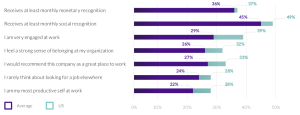It’s long been understood that ‘recognition’ is a direct line of sight into how companies value their talent.
And yet, Achievers Workforce Institute (AWI) recently uncovered glaring gratitude gaps in many organizations.
For instance, we found that women are 28% less likely to receive at least monthly monetary recognition than the overall average.
This gap must be closed in 2024. Because when a company is not recognizing historically marginalized groups at the same rate, it sends a signal about what that company truly values.
So what must be done to arrest this?

Given the current economic climate, companies’ budgets are invariably being cut, often resulting in layoffs.
For remaining staff it often means they’re working in a leaner team, meaning more work for them and their colleagues. They’re most likely feeling increased levels of burnout – which translates in higher staff turnover and headaches for the HR team.
How simple it would be to ramp up recognition just when staff need it most.
According to the latest AWI research, more than half of employees say feeling better recognized would inspire productivity and help maintain morale during layoffs.
However, this only spotlights how important it is that employees are recognized equally and consistently.
So is this happening?
Unfortunately not. New AWI data shows people with disabilities receive less frequent recognition than average. This is despite AWI also finding 84% of HR leaders report that diversity, equity, and inclusion (DEI) is a high priority for their organization.
How to level out the recognition playing field
The first step to making a change is being more self-aware of your recognition tendencies.
Consider how often you give praise to diverse groups across your organization and check in with yourself: do you notice a disparity?
If your company has a recognition platform tool, it can break down how and when recognition is provided, easily identifying any marginalized groups.
It’s important to pay close attention to those alerts. If your platform doesn’t have these capabilities this could be a call to action for your organization.
Organizations can easily identify recognition gaps and introduce specific training and campaigns to improve recognition equity by leveraging a recognition platform program.
Now, for most people, the idea of having to download or use another app for work isn’t all that appealing. Recognition should be available to teams, individuals, business units, and locations, without bias and using a mobile-compatible recognition platform for everyone, including if you work from home or are a deskless worker.
Plus, it’s an easy way for you and your co-workers to receive the recognition you deserve. It is paramount that organizations find a way for everyone to participate in the program and by doing so, over time, authentic recognition will instill a true culture of recognition and belonging.
Recognition can make you a dynamic future leader
People leaders make or break employees’ experience at work.
While most managers are well-intentioned, many leaders haven’t been provided with the tools or training to succeed in their roles, especially when it comes to recognition.
AWI found that only 53% of managers receive training on recognition best practices, and because of this, many don’t know the qualities needed to make praise effective and authentic.
Manager must up-level their skills as a way of becoming an effective and dynamic company leader.
Recognition should be personal, specific, timely and impact-oriented. Managers need to be able to hone in on what workers prefer when it comes to recognition, including whether they prefer that praise to be public or private.
The first step HR can take is to provide specific recognition training (it does exist), for management.

People who say their managers regularly recognize them are also more likely to report that they, themselves frequently recognize others, making a case for a “pay-it-forward” culture of recognition.
Ultimately, the goal is not only to effectively learn why recognition is a vital aspect for every employee but also how HR can play a pivotal role in propelling a positive and encouraging work environment. Employees are the backbone of every company and managers must inspire action from the top down by establishing a culture of consistent praise. That change can start with you.
So, what does authentic recognition look like to you?
At the end of the day, all staff want authentic recognition that reflects their hard work and dedication. Without it everything that follows simply falls flat.
When managers and company leaders listen to employees, they are better equipped to roll out practices that align with employees’ unique wants and needs, driving engagement and retention.
Meaningful action and authentic recognition are motivating drivers of trust and can help increase your teams’ resiliency in tough times.
So, be honest with yourself and your co-workers.
What does authentic recognition look like to you?
What do you value and what doesn’t resonate?
Knowing what your specific needs are can help your co-workers and managers navigate how they provide feedback, helping close the recognition gap in 2024 and beyond.
What the stats say: How does America do recognition?
(Source: AWI)


